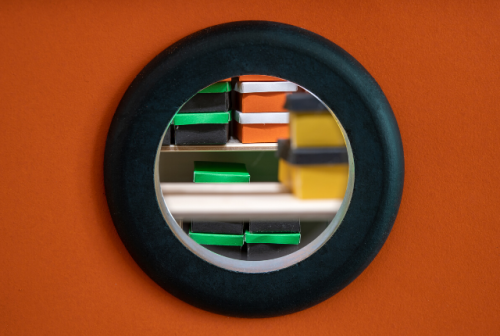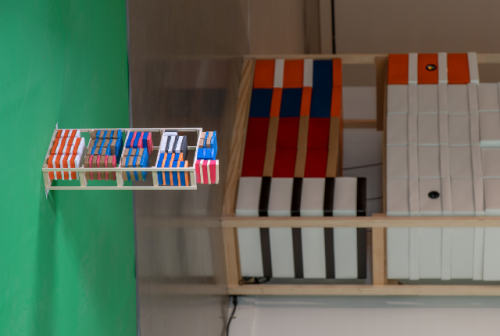

Chris Rackley, Does Your Shoe Have a Boy Inside?
Chris Rackley
b. 1978, West Columbia, South Carolina
Lives and works in Rochester
Biography
Chris Rackley’s childhood informs Does Your Shoe Have a Boy Inside? Viewers peek, play and climb inside the imaginary world a boy stuck in a back storeroom of his father’s shoe shop. From the miniature to the gigantic, shoe boxes as large as a room and as small as a dollhouse toy provoke the viewer to consider how memory works and how these memories shape us.
Artist Statement
My art plays with the boundary between reality and fantasy to confront existential questions of isolation. My experiments with live video combined with diorama elements draw attention to the mechanics behind moving images, which are normally hidden from view. The works create fictional landscapes, inspired by science fiction, to conjure a sense of estrangement in desolate spaces. Audiences are given the ability to physically play with the dioramas, thereby altering the video and gaining a sense of control over feelings of isolation.
Recently I have been exploring personal memory and family history to gain control over my own anxiety. If memories can be reconstructed accurately enough, can personal shame and fear be located and disarmed at the source? This pursuit has influenced my creative research and practice as I strive to understand anxiety in an interpersonal and cultural context. Does Your Shoe Have a Boy Inside? engages personal memory with overlaps of childhood fears and the anxieties of consumer culture and specialized labor associated with shopping malls.
In the 1980s my father managed a shoe store at Gwinnett Place Mall in a suburb near Atlanta, Georgia. I often stayed in the stockroom, a hidden space with maze-like corridors of shelving racks filled with shoeboxes. I developed an active interior life, transforming empty boxes into robots and time machines to escape into imaginary worlds.
Does Your Shoe Have a Boy Inside? gives audiences access to my memories of the stockroom. I made shoeboxes at different scales: miniature, life size, and gigantic. Each encounter with a shoebox reveals a tableau based on a memory. Visitors are invited to look inside life-size shoeboxes to observe hidden scenes displaying evidence of the repetitive, specialized labor of shoe store employees. By hand-making elements over and over, I transform the shoe store labor into artistic labor and play. In another part of my installation, audiences encounter a giant shoebox where they can view video that depicts childhood fears. Finally, the installation includes a simple green-screen studio that allows visitors to virtually enter the stockroom space. They see themselves composited into a video projection depicting rows of shelving racks where a child furtively plays make-believe.
Does Your Shoe Have a Boy Inside? reveals hidden spaces, actions, and emotions. Audiences are given access to a kind of memory palace that stores feelings of shame and fear. The shifting scale of shoeboxes relative to the body allows visitors to slide between the viewpoints of childhood and adulthood. I hope viewers will feel encouraged to confront their own anxieties and feel greater empathy for others and for their own childhood selves.
The frantic and monotonous busyness of selling and shopping once contained in the shopping mall experience now happens everywhere through handheld technologies, minimizing and disrupting human connection. My project presents busyness as both a source of anxiety and an escape from anxiety, inviting visitors to consider how this tension affects authentic connection with other people.